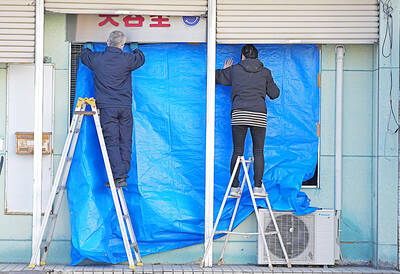A defense white paper approved by the Japanese Cabinet on Tuesday said that Taiwan was falling behind China in modernization of weapons systems and budget allocations for defense spending.
The overall military balance was shifting in favor of China and the gap was growing wider, the paper said, adding that US arms sales to Taiwan and self-developed weapon programs might be the key to restoring the equilibrium.
Thirty-four pages were about China, including reports on Chinese naval activity expanding to the entire Asia-Pacific region, including Japan.
The potential effects of this on international security are extremely concerning, the paper said.
As of 2014, Taiwan had 215,000 combat-ready military personnel, but the nation’s policy favoring an all-volunteer military could see that number fall to 170,000 to 190,000 by 2019, which would require the adoption of cutting-edge technology and implementation of coordinated combat exercises between the branches of the armed forces, the paper said.
The Republic of China (ROC) Army fields 140,000 troops, including the Marine Corps, although it can mobilize up to 1.66 million, it said.
The ROC Navy has Keelung-class destroyers and other more modernized platforms, while the ROC Air Force has a fleet of F-16A/B jets, Mirage 2000s and the self-produced Indigenous Defense Fighter, the paper said.
Taiwan has Skybow II surface-to-air missiles, Hsiung Feng II anti-ship missiles, Hsiung Feng II-E cruise missiles and so-called “aircraft carrier killer” supersonic Hsiung Feng III anti-ship missiles, it said.
While Taiwan has introduced high-speed stealth missile boats, the increasing capabilities of the Chinese missile arsenal, the People’s Liberation Army (PLA) Navy and the PLA Air Force spell “problems for Taiwan’s weapons modernization,” it said.
Taiwan’s defense budget has not increased in nearly two decades, while China’s “public” defense budget last year was 15 times that of Taiwan’s, it said. Chinese defense spending this year was the equivalent of ¥1.4 trillion (US$12.8 billion), an increase of 7.1 percent from last year.
Compared with defense spending in 1988, China’s defense budget has increased 49-fold, it said, adding that its published budget was only “a portion” of its actual expenditure.
The PLA has overwhelming forces compared with Taiwan, but despite the large number of amphibious landing ships it possesses, its capability to conduct an amphibious landing in Taiwan remains limited, the paper said.
China has the superior numbers, and despite Taiwan’s edge in quality of troops and equipment, “the quality gap is rapidly closing,” it said.

Taiwanese were praised for their composure after a video filmed by Taiwanese tourists capturing the moment a magnitude 7.5 earthquake struck Japan’s Aomori Prefecture went viral on social media. The video shows a hotel room shaking violently amid Monday’s quake, with objects falling to the ground. Two Taiwanese began filming with their mobile phones, while two others held the sides of a TV to prevent it from falling. When the shaking stopped, the pair calmly took down the TV and laid it flat on a tatami mat, the video shows. The video also captured the group talking about the safety of their companions bathing

US climber Alex Honnold is to attempt to scale Taipei 101 without a rope and harness in a live Netflix special on Jan. 24, the streaming platform announced on Wednesday. Accounting for the time difference, the two-hour broadcast of Honnold’s climb, called Skyscraper Live, is to air on Jan. 23 in the US, Netflix said in a statement. Honnold, 40, was the first person ever to free solo climb the 900m El Capitan rock formation in Yosemite National Park — a feat that was recorded and later made into the 2018 documentary film Free Solo. Netflix previewed Skyscraper Live in October, after videos

Starting on Jan. 1, YouBike riders must have insurance to use the service, and a six-month trial of NT$5 coupons under certain conditions would be implemented to balance bike shortages, a joint statement from transportation departments across Taipei, New Taipei City and Taoyuan announced yesterday. The rental bike system operator said that coupons would be offered to riders to rent bikes from full stations, for riders who take out an electric-assisted bike from a full station, and for riders who return a bike to an empty station. All riders with YouBike accounts are automatically eligible for the program, and each membership account

A classified Pentagon-produced, multiyear assessment — the Overmatch brief — highlighted unreported Chinese capabilities to destroy US military assets and identified US supply chain choke points, painting a disturbing picture of waning US military might, a New York Times editorial published on Monday said. US Secretary of Defense Pete Hegseth’s comments in November last year that “we lose every time” in Pentagon-conducted war games pitting the US against China further highlighted the uncertainty about the US’ capability to intervene in the event of a Chinese invasion of Taiwan. “It shows the Pentagon’s overreliance on expensive, vulnerable weapons as adversaries field cheap, technologically